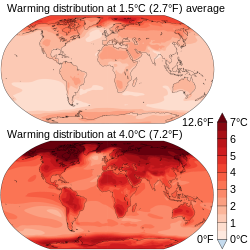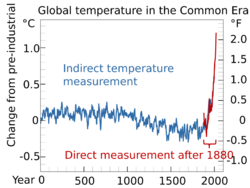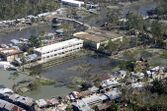Earth:Global surface temperature
In earth science, global surface temperature (GST; sometimes referred to as global mean surface temperature, GMST, or global average surface temperature) is calculated by averaging the temperatures over sea (sea surface temperature) and land (surface air temperature).
Series of reliable global temperature measurements began in the 1850—1880 time frame (this is called the instrumental temperature record). Through 1940, the average annual temperature increased, but was relatively stable between 1940 and 1975. Since 1975, it has increased by roughly 0.15 °C to 0.20 °C per decade, to at least 1.1 °C (1.9 °F) above 1880 levels.[3] The current annual GMST is about 15 °C (59 °F),[4] though monthly temperatures can vary almost 2 °C (4 °F) above or below this figure.[5]
Definition
The IPCC Sixth Assessment Report defines global mean surface temperature (GMST) as follows: GMST is the "estimated global average of near-surface air temperatures over land and sea ice, and sea surface temperature (SST) over ice-free ocean regions, with changes normally expressed as departures from a value over a specified reference period".[6]:2231
In comparison, the global mean surface air temperature (GSAT) is the "global average of near-surface air temperatures over land, oceans and sea ice. Changes in GSAT are often used as a measure of global temperature change in climate models."[6]:2231
Relevance
Changes in global temperatures over the past century provide evidence for the effects of increasing greenhouse gasses. When the climate system reacts to such changes, climate change follows. Measurement of the GST(global surface temperature) is one of the many lines of evidence supporting the scientific consensus on climate change, which is that humans are causing warming of Earth's climate system.

Measurement and calculation
The global surface temperature (GST) is calculated by averaging the temperatures over sea (sea surface temperature) and land (surface air temperature).
Observations
Effects
See also
References
- ↑ ((PAGES 2k Consortium)) (2019). "Consistent multidecadal variability in global temperature reconstructions and simulations over the Common Era" (in en). Nature Geoscience 12 (8): 643–649. doi:10.1038/s41561-019-0400-0. ISSN 1752-0894. PMID 31372180. PMC 6675609. https://www.nature.com/articles/s41561-019-0400-0.
- ↑ "Global Annual Mean Surface Air Temperature Change". NASA. https://data.giss.nasa.gov/gistemp/graphs_v4/.
- ↑ World of change: Global Temperatures The global mean surface air temperature for the period 1951-1980 was estimated to be 14 °C (57 °F), with an uncertainty of several tenths of a degree.
- ↑ "Solar System Temperatures". National Aeronautics and Space Administration (NASA). 4 September 2023. https://science.nasa.gov/resource/solar-system-temperatures/. (link to NASA graphic)
- ↑ "Tracking breaches of the 1.5 °C global warming threshold". Copernicus Programme. 15 June 2023. https://climate.copernicus.eu/sites/default/files/custom-uploads/Page%20Uploads/daily%20GAT.png.
- ↑ 6.0 6.1 IPCC, 2021: Annex VII: Glossary [Matthews, J.B.R., V. Möller, R. van Diemen, J.S. Fuglestvedt, V. Masson-Delmotte, C. Méndez, S. Semenov, A. Reisinger (eds.)]. In Climate Change 2021: The Physical Science Basis. Contribution of Working Group I to the Sixth Assessment Report of the Intergovernmental Panel on Climate Change [Masson-Delmotte, V., P. Zhai, A. Pirani, S.L. Connors, C. Péan, S. Berger, N. Caud, Y. Chen, L. Goldfarb, M.I. Gomis, M. Huang, K. Leitzell, E. Lonnoy, J.B.R. Matthews, T.K. Maycock, T. Waterfield, O. Yelekçi, R. Yu, and B. Zhou (eds.)]. Cambridge University Press, Cambridge, United Kingdom and New York, NY, USA, pp. 2215–2256, doi:10.1017/9781009157896.022.
 |






